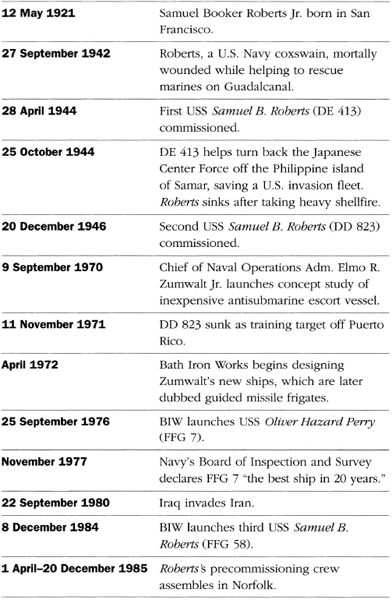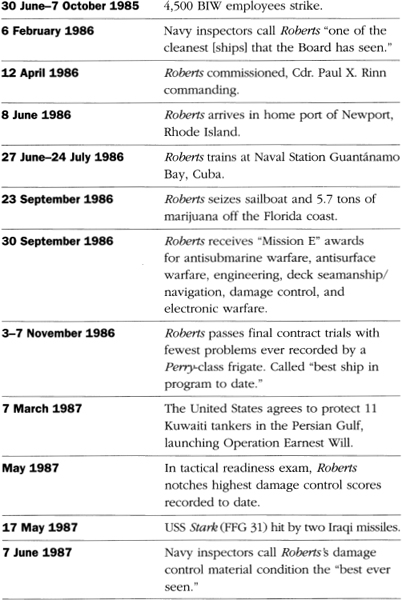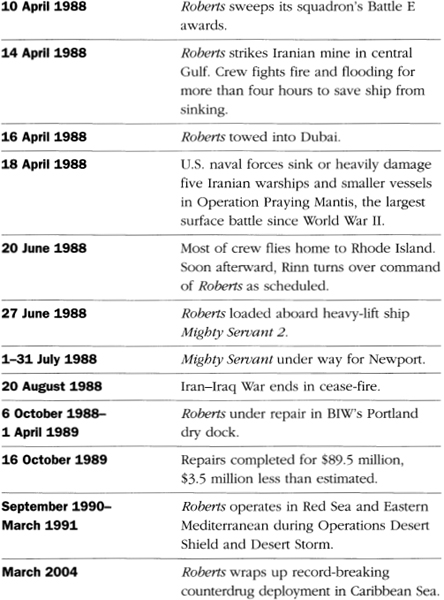No Higher Honor (2 page)
Authors: Bradley Peniston





No
     Â
Higher
     Â
Honor
Those Are Mines
A
t twenty-five knots, the sea came on quickly. Its surface, wrinkled and opaque, rushed toward the warship, split against the steel prow, and became a fleeting trail of foam pointing back toward Kuwait. Four decks above the waterline, Seaman Bobby F. Gibson leaned over the forecastle rail and twisted the focus knob on his binoculars. His metal chair, bolted to the main deck just behind the bow, afforded a panoramic view of the central Persian Gulf. The nineteen-year-old from Walkertown, North Carolina, took in the scene one small circle at a time.
Gibson ignored the horizon; the radar boys in the combat information center would spot incoming fighter jets and naval craft before any human lookout could. Instead, he lowered his gaze and surveyed the choppy surface off the port bow. He found a featureless disc of seawater, devoid even of the trash bags and jetsam of a busy sea-lane, a dark fractal veil over the depths. The sailor rotated his head five degrees to the right, paused, repeated the motion, and then repeated it again. Each glance lasted a few seconds; each circle overlapped the next. Countless four-hour watches had honed Gibson's technique, and after three months on deployment his scan was smooth and automatic.
A lookout's duty required him to take note of ships, planes, foghorns, an unaccustomed rush of water on steelâanything seen or heardâand pass the word via the sound-powered phone that hung around his neck like a folksinger's harmonica. In busy waters, Gibson's finger rarely left the talk button. Close to shore there were dhows, the ancient sailboats that had borne the region's trade for centuries. Out here in the shipping lanes, traffic was dominated by modern merchant ships and by the supertankers that hauled petrochemical succor to an oil-thirsty world. They went by alone or in ragged convoys, dwarfing the gray-hulled warships
that herded them along. From time to time a black smudge tinted the horizon: smoke billowing from the bombed-out carcass of a tanker.
Today there wasn't much going on, and Gibson took a moment to appreciate his surroundings. The afternoon curtain of humidity and airborne dust had retreated nearly to the horizon, and yet a protective layer of cloud still shielded him from the beating April sun. A bit earlier, he had spotted a pod of dolphins off the bow, and his report to the bridge had drawn a small knot of shipmates to the forecastle. “Pretty nice,” he thought.
1
Gibson enjoyed his job; he often traded shifts with shipmates who preferred their air-conditioned refuges. The heat didn't bother the North Carolina native, and he shrugged off the desert grit that blew up from the Arabian Peninsula and down from the far-off mountains of Iran. For the Gulf was at war, and if your ship had to play shepherd in a combat zone, at least you could get the best seat in the house.
Iran and Iraq had been fighting ever since Gibson was in grade school. The land campaign had long ago devolved into a brutal, grinding stalemate, and the two countries had taken the fight to sea, where they slashed at the oil tankers that were each other's economic jugulars. Baghdad's fighter planes left smoking holes in Iranian ships, and Tehran's naval forces mounted attacks with guns and rocket-propelled grenades. Both sides were less than meticulous about identifying their prey; neutral and even friendly ships suffered the consequences. Together they had turned the inland sea into the world's most hazardous watercourse.
The United States had tried to keep out of the frayâU.S. policy makers would have preferred both sides to lose, if that were possible, but the region's oil gave it a strategic significance that could not be ignored. Reagan administration officials muddled along at arm's length, passing battlefield intelligence to Baghdad even as they secretly shipped arms to Tehran, until the Kuwaiti monarchy forced the White House's hand in late 1986 by extracting a promise to protect its tankers.
In mid-1987 the U.S. Navy launched Operation Earnest Willâits first convoy operation since World War IIâand began to dispatch dozens of U.S. warships to the region. One of them was Gibson's: USS
Samuel B. Roberts
(FFG 58), a guided missile frigate on its maiden deployment. The 445-foot
Roberts
was small for a contemporary American surface
combatant; it belonged to the inexpensive and oft-dismissed
Oliver Hazard Perry
class. But the ship was a stout craft, built by Maine's venerable Bath Iron Works, powered by modified aircraft engines, and better armed than it first appeared.
And its crew was second to none in the Atlantic Fleet. Cdr. Paul X. Rinn had pushed his sailors to be the bestâto be the New York Yankees, as the Bronx-born combat veteran put it. Captain and crew had spent most of the previous two years at sea, mastering the myriad skills of naval warfare. Their commodore had recently named
Roberts
the best
Perry
-class frigate in his squadron, and fleet instructors declared it the best ship they'd seen in years. Two months in the Persian Gulf had put those skills to the test. Since arriving in February 1988, the crew had handled convoys, patrols, and a rescue at sea. They had chased away Iranian warships and warded off Iraqi fighters. They had guarded the secret mobile operating bases in the northern Gulf and launched black army helicopters on shadowy missions.
Danger was omnipresent. Less than a year had passed since an Iraqi jet had fired two missiles into the USS
Stark
(FFG 31), killing thirty-seven U.S. sailors. Baghdad called it a tragic accident, but the
Roberts
crew took it as a bloody warning. They had redoubled their training efforts and since arriving in the Gulf had remained constantly vigilant. On deck, the lookouts kept their eyes peeled; down in the darkened combat information center, radar operators peered at cathode-ray screens around the clock. They sorted the seething mass of green specks into tankers and warships, dhows and armed speedboats, airliners and fighter jets. Every dot concealed a different way to dieâcollision, accident, or deliberate attack.
But many captainsâthe
Roberts
's Rinn among themâworried even more about a threat that didn't show up on radarscopes: the naval mine. Since World War II, mines had damaged more U.S. warships than missiles, guns, and bombs combined. A floating Iranian weapon had clobbered a tanker on the very first Earnest Will convoy. Its three escorting warships completed the journey in the tanker's wake, huddling behind the wounded giant. And yet the navy still afforded its surface combatants no mine-detection gear more sophisticated than a pair of binoculars and a sharp-eyed lookout.
ON THE FORECASTLE
, Gibson raised his binoculars again. This time, there was something out there. A half-mile off the starboard bow, three objects bobbed some distance apart. They were black, like the ubiquitous floating trash bags. But these had protrusions and rounded carapacesâmaybe they were dead sheep? Gibson had seen plenty of those bloated forms, the cast-off dead of Australian livestock carriers. These objects were different, shinier.
That's a mine!
he thought. He squeezed the round microphone under his chin, and a carbon-filled cell transformed the sound of his voice into electrical impulses. “Bridge, forecastle,” he said, calling the pilothouse.
On the bridge, Lt. Robert Firehammer raised his own binoculars. A quick look told the officer of the deck what he needed to know. “All engines stop,” Firehammer told the helmsman. The ship began to slow, but he decided to stamp on the brakes. “All engines back one-third,” he said. The bronze blades on the
Roberts
's seventeen-foot screw swiveled on their hubs, biting backward into the sea. The ship shuddered. Fire-hammer pulled a heavy black handset from a gray box beneath the windscreen. One deck down, its twin rang in the captain's L-shaped cabin.
Rinn had been going over the week's menu with Kevin Ford, the ship's head cook. It was 14 April, which meant tomorrow would be the halfway point of the deployment, and Ford had planned a steak and lobster dinner to celebrate. The captain objected to a certain item that seemed to be coming up a lot lately. “C'mon, Chief, not so much spinach, huh?” Ford just grinned; he was not above tweaking his commanding officer with a surfeit of the green leafy vegetable.
Rinn knew something was happening the moment the ship began to back down. He had commanded this ship since it was an inanimate pile of steel on a Maine riverbank, and he felt every vibration as if it were his own body. He answered the phone, and in almost the same movement was out the door and up the ladder to the bridge. Through the door to the bridge wing, the floating black forms were clearly visible less than half a mile awayâthree of them, lined up.
Those are mines
, Rinn thought.
In a minefield the only clear path to safety was the wake. The captain was an excellent shiphandler, by instinct and by years at sea, but backing a frigate wasn't easy. It was hydrodynamically akin to throwing a paper airplane backward. Rinn gripped the rail and gazed aft to the pale
white stripe that stretched back to clear water. The ship began to creep backward, powered by a pair of electric outboard motors customarily used for docking in safe harbor. Moments went by.
We're going to get out
, he told himself. There were those, later, who imagined they heard a scrape of metal on metal.
The explosion grabbed the frigate and shook it from stem to stern. The ship flexed, flipping Gibson backward out of his chair. Superhot gases rushed through a hole in the hull, setting fires at the ship's very core. A wall of seawater followed within seconds, ripping open fuel tanks and flooding the engine room. Far above, a ball of flame erupted from the ship's stack, and fiery chunks of debris rained down on the deck. With reflexes imbued by thousands of hours of drills, sailors rushed to pull hoses from bulkhead racks. But when they pulled the levers on the heavy brass nozzles, mere trickles came out. Somewhere under their feet, something was very wrong.
It would take Rinn and his crew hours to add up all the clues, but the news they gathered early on wasn't good. The main engine room and another capacious engineering space were inundated with oil-slicked water, and a third compartment was filling rapidly. Lose that one, and the frigate would likely plunge to the bottom of the Gulf. The
Samuel B. Roberts
was flooding, on fire, surrounded by sharks and sea snakes, alone in a minefield in a sea at war. Its crew was fighting for their lives. But they faced the battle well prepared, well led, and with a sturdy ship beneath their feet. The outcome of the next few hours would, in no small part, be determined by events that began many years before.
